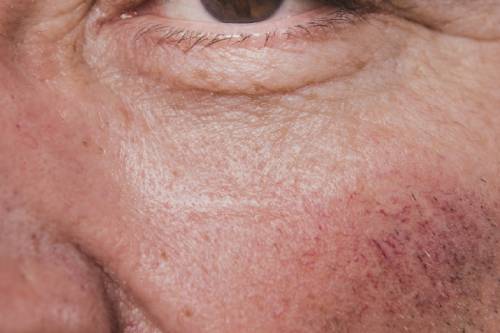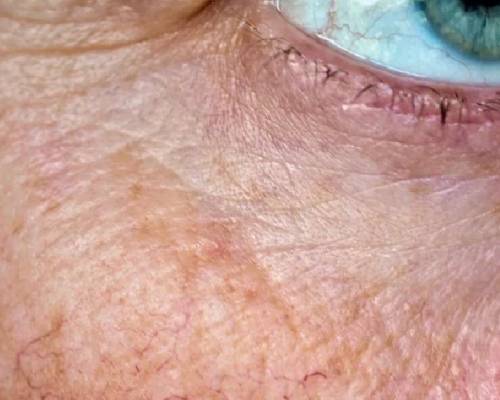Skin Health & Beauty Clinic
Facial Thread Veins in Bournemouth

What are facial thread veins?
Facial thread veins, also known as telangiectasia, are delicate blood vessels near the skin’s surface, appearing as thin red, purple, or blue lines. These veins often result from factors such as sun exposure, weather changes, alcohol consumption, hormonal fluctuations (like pregnancy), sudden pressure changes (such as sneesing), or genetic predisposition. Individuals with rosacea may also experience facial thread veins due to red and flushed skin.
We, at Skin Health & Beauty Clinic, located in Bournemouth, Dorset, specialised in Electrosurgery which is a procedure that uses electrical currents to remove or cauterise thread veins. This procedure is performed by our qualified and professional clinician.
Benefits of
Facial Thread Veins Removal in
Skin Health & Beauty in Bournemouth?
In the pursuit of flawless skin, one often encounters various skin concerns, with facial thread veins being a common issue many individuals face. However, instead of viewing them as mere imperfections, it’s time to explore the surprising benefits that come with facial thread vein removal. Let’s delve into the world of radiant skin and discover the positive impact of banishing those delicate red, purple, or blue lines.
Enhanced Aesthetics: Facial thread veins, also known as telangiectasia, can be a source of concern for those seeking a smooth complexion. The primary benefit of thread vein removal with our qualified clinician at Skin Health & Beauty in Bournemouth is the immediate improvement in aesthetics. By eliminating these visible veins, individuals can enjoy a clearer and more even skin tone, boosting their confidence and promoting a youthful appearance.
Improved Skin Health: Beyond aesthetics, addressing facial thread veins contributes to overall skin health. The removal process involves advanced treatments such as Electrosurgery therapy, which is a procedure that uses high-frequency electrical currents for the removal of facial thread veins.
Relief from Discomfort: For some, facial thread veins may be associated with discomfort or sensitivity. Laser thread vein removal not only addresses the visible veins on the surface but can also provide relief from any associated discomfort, allowing individuals to enjoy a more comfortable and soothing experience.
Prevention of Further Issues: Leaving facial thread veins untreated may lead to potential complications, such as increased visibility or even the development of more severe skin concerns. By opting for removal treatments at Skin Health & Beauty in Bournemouth , individuals can prevent the progression of these issues, ensuring long-term skin health and preserving the natural beauty of their complexion.
Boosted Confidence and Emotional Well-being: The emotional impact of achieving clearer, radiant skin should not be underestimated. Banishing facial thread veins can significantly boost an individual’s self-esteem, leading to increased confidence and a more positive outlook on life. The journey towards radiant skin becomes a transformative experience that extends beyond the physical realm.

FAQ
Frequently Asked
What causes spider veins on the face?
Spider veins on the face, also known as facial telangiectasia, can be caused by various factors. These delicate, visible blood vessels near the skin’s surface may develop due to:
Sun Exposure: Prolonged exposure to ultraviolet (UV) rays from the sun can weaken and damage the skin, leading to the development of spider veins on the face.
Genetics: A family history of spider veins can increase the likelihood of developing them. Genetic factors play a role in the integrity of blood vessels and skin structure.
Rosacea: Individuals with rosacea, a chronic skin condition characterised by redness and flushing, are more prone to developing spider veins on the face.
Hormonal Changes: Fluctuations in hormones, such as those occurring during pregnancy, puberty, or menopause, can contribute to the development of spider veins.
Trauma or Injury: Injuries to the face or trauma, even if minor, can damage blood vessels and result in the formation of spider veins.
Alcohol Consumption: Excessive alcohol intake can dilate blood vessels, making them more visible and increasing the risk of developing spider veins on the face.
Temperature Extremes: Sudden changes in temperature, particularly exposure to extreme cold or heat, can contribute to the development of spider veins.
Skin Aging: The natural aging process can lead to a loss of skin elasticity and collagen, making blood vessels more visible and increasing the likelihood of spider veins.
Inflammatory Skin Conditions: Skin conditions associated with inflammation, such as eczema or dermatitis, can contribute to the development of facial spider veins.
Use of Topical Steroids: Prolonged or improper use of topical steroids on the face may weaken blood vessel walls, making spider veins more likely to occur.
How can I get rid of facial spider veins?
How do I prevent spider veins on my face?
While it may not be possible to prevent spider veins entirely, there are several lifestyle measures you can take to reduce the risk of their development on your face and minimize their visibility. Here are some preventive measures:
Sun Protection: Protect your skin from harmful UV rays by applying sunscreen with a high SPF, wearing a wide-brimmed hat, and avoiding prolonged sun exposure, especially during peak hours.
Healthy Diet: Consume a diet rich in antioxidants, vitamins, and minerals. These nutrients support skin health and may contribute to the prevention of spider veins.
Hydration: Stay well-hydrated to maintain the elasticity of your skin. Proper hydration supports overall skin health and may reduce the risk of visible veins.
Avoid Extreme Temperatures: Sudden changes in temperature, such as exposure to extreme heat or cold, can contribute to the development of spider veins. Take measures to protect your face in extreme weather conditions.
Gentle Skincare: Be gentle with your facial skin. Avoid harsh exfoliation and aggressive facial treatments that may damage blood vessels.
Manage Rosacea: If you have rosacea, work with a dermatologist to manage the condition effectively. Controlling rosacea symptoms can help prevent the development of facial spider veins.
Exercise Regularly: Engage in regular physical activity to promote healthy blood circulation. Exercise helps prevent blood pooling in the veins, reducing the risk of spider veins.
Avoid Smoking: Smoking has detrimental effects on blood vessels and can contribute to the development of spider veins. Quitting smoking can have positive effects on overall vascular health.
Compression Stockings: If you are prone to spider veins or have a family history, consider using compression stockings to support healthy blood flow, especially if you spend long periods standing.
Manage Hormones: If hormonal fluctuations are contributing to spider veins, such as during pregnancy or menopause, discuss potential preventive measures with your healthcare provider.
Regular Check-ups: Keep regular appointments with a dermatologist or skincare professional for skin assessments and early intervention if needed.
Where can I have facial thread vein removal treatment near me?
At Skin Health & Beauty Clinic in Bournemouth, located in Pokesdown, near Christchurch and Southbourne in Dorset. Our address is 878, Christchurch road, Bournemouth BH76DJ
Why do I have red veins on my face?
Red veins on the face, often referred to as facial spider veins or telangiectasia, can result from various factors. These visible blood vessels near the skin’s surface may appear red, purple, or blue and can be attributed to:
Sun Exposure: Prolonged exposure to ultraviolet (UV) rays from the sun can damage the skin, leading to the development of visible blood vessels.
Genetics: A family history of facial spider veins can increase the likelihood of their development. Genetic factors play a role in the integrity of blood vessels and skin structure.
Rosacea: Rosacea is a chronic skin condition characterised by redness and flushing. It can cause the enlargement of blood vessels, leading to the appearance of red veins on the face.
Hormonal Changes: Fluctuations in hormones, such as those occurring during pregnancy, puberty, or menopause, can contribute to the development of visible blood vessels.
Trauma or Injury: Injuries to the face or trauma, even if minor, can damage blood vessels and result in the appearance of red veins.
Alcohol Consumption: Excessive alcohol intake can dilate blood vessels, making them more visible and increasing the risk of facial spider veins.
Temperature Extremes: Sudden changes in temperature, particularly exposure to extreme cold or heat, can contribute to the development of visible blood vessels.
Skin Aging: The natural aging process can lead to a loss of skin elasticity and collagen, making blood vessels more visible.
Inflammatory Skin Conditions: Skin conditions associated with inflammation, such as eczema or dermatitis, can contribute to the development of red veins on the face.
Topical Steroids: Prolonged or improper use of topical steroids on the face may weaken blood vessel walls, making red veins more likely to occur.
Are facial thread veins dangerous?
Facial thread veins, also known as telangiectasia or spider veins, are generally not dangerous from a health perspective. They are small, visible blood vessels near the surface of the skin and, in most cases, are considered a cosmetic concern rather than a serious medical issue.
Does facial vein treatment hurt?
The level of discomfort or pain experienced during facial vein treatment can vary depending on the specific procedure used, individual pain tolerance, and the size and location of the veins being treated. We, at Skin Health and Beauty Clinic in Bournemouth, apply Sclerotherapy that involves injecting a solution into the veins to collapse them. While the injections may cause a slight stinging or burning sensation, it is usually brief and well-tolerated. This treatment is also used for larger veins.
How many facial vein treatments will I need?
The number of sclerotherapy treatments needed for facial veins can vary based on factors such as the size, number, and response of the veins being treated, as well as individual variations in skin type and healing. Typically, multiple sessions are required for optimal results.
Here are some general considerations:
Size and Number of Veins: Larger or a higher number of facial veins may require more sessions to achieve the desired outcome. Sclerotherapy is often more effective for smaller veins.
Individual Response: Individual responses to sclerotherapy can vary. Some people may see significant improvement after a few sessions, while others may require additional treatments.
Treatment Plan: Your healthcare provider will create a customised treatment plan during the initial consultation. This plan may include the recommended number of sessions based on the specific characteristics of your facial veins.
Interval Between Sessions: Sclerotherapy sessions are typically spaced a few weeks apart to allow for proper healing and to assess the response to the treatment. The interval between sessions may vary depending on the individual and the provider’s recommendations.
Maintenance Sessions: In some cases, maintenance sessions may be recommended to address new veins that may appear over time. These sessions help maintain the results achieved.
It’s crucial to have realistic expectations and be patient throughout the treatment process. While some improvement is often noticeable after each session, the final results may take time to fully manifest.
What aftercare is required after facial thread vein treatment?
After undergoing facial thread vein treatment with sclerotherapy, it’s essential to follow specific aftercare instructions provided by your healthcare provider to ensure proper healing and minimize potential side effects. While instructions may vary based on individual cases and the specific sclerotherapy technique used, here are general aftercare guidelines:
Compression: Your healthcare provider may recommend wearing compression stockings or bandages after the procedure. Compression helps support the treated blood vessels and reduces the risk of swelling and bruising.
Avoid Sun Exposure: Protect the treated area from direct sunlight for a specified period after the procedure. Use sunscreen with a high SPF to prevent sun damage and minimise the risk of hyperpigmentation.
Gentle Skincare: Avoid harsh skincare products and treatments on the treated area for a specified time. Gentle cleansing and moisturizing are generally recommended.
Avoid Hot Baths and Saunas: Refrain from hot baths, saunas, and hot tubs for a certain period after treatment, as heat can dilate blood vessels and potentially interfere with the healing process.
Stay Active: Engage in light physical activity, such as walking, to promote blood circulation and support the healing process. However, avoid strenuous exercise for the first few days after treatment.
Elevate Legs: If the treatment involves veins on the legs, elevating your legs when resting can help reduce swelling.
Follow-up Appointments: Attend any scheduled follow-up appointments with your healthcare provider. They will assess the results of the treatment and address any concerns or questions you may have.
Avoid Smoking: If you smoke, consider avoiding smoking or minimising tobacco use, as smoking can have negative effects on blood vessel health and overall healing.
Stay Hydrated: Drink plenty of water to stay hydrated, as adequate hydration supports the healing process.
Can I wear make-up after facial vein treatment?
After facial vein treatment by sclerotherapy, it’s generally advisable to avoid applying makeup directly to the treated area for a specified period, usually on the day of the procedure. The skin may be sensitive, and applying makeup immediately afterward could potentially irritate the treated veins or introduce contaminants to the healing skin.
sKIN HEALTH & BEAUTY CLINIC & ACADEMY ADDRESS
Find our Clinic
Opening Times
| Day | Hours |
|---|---|
| Monday | 9:30 - 14:00 16:00 - 20:00 |
| Tuesday | 9:30 - 14:00 16:00 - 20:00 |
| Wednesday | 9:30 - 14:00 16:00 - 20:00 |
| Thursday | 9:30 - 14:00 16:00 - 20:00 |
| Friday | 9:30 - 14:00 16:00 - 20:00 |
| Saturday | 9:00 - 20:00 |
| Sunday | 10:00 - 14:00 |
Clinic Address
878, Christchurch road, Bournemouth BH76DJ
Telephone
07393 770773
Finding us
Our clinic is located on the left hand side of Christchurch Road a few meters away from Kwik Fit towards Iford roundabout, just at the Hannington Road Bus Stop. There is plenty of transport link to Bournemouth, Poole and Chirstchurch all day and free parking outside the clinic for an hour and in the side roads unlimited.
